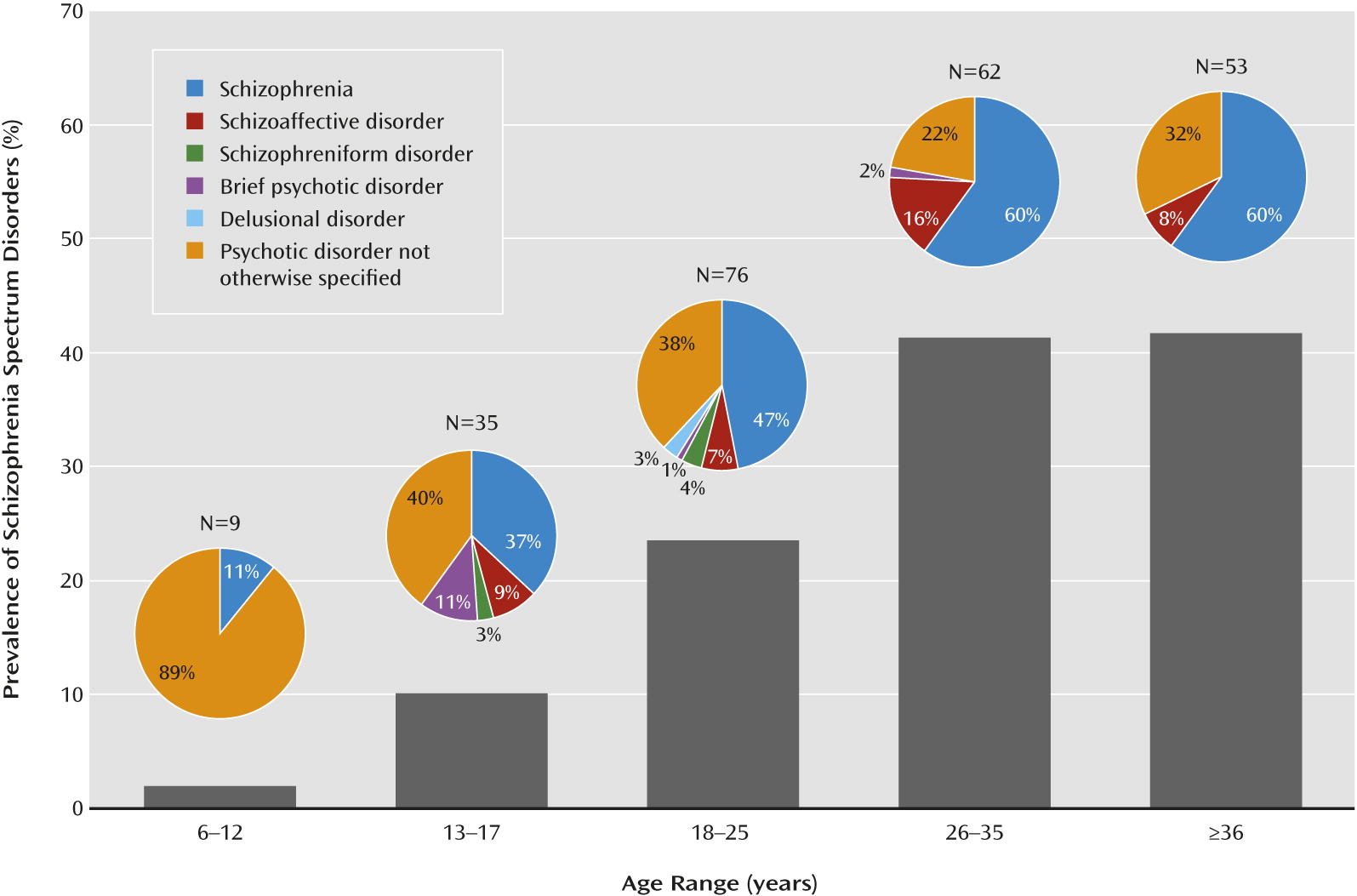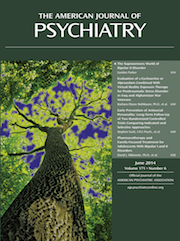Psychiatric Disorders From Childhood to Adulthood in 22q11.2 Deletion Syndrome: Results From the International Consortium on Brain and Behavior in 22q11.2 Deletion Syndrome
Abstract
Objective
Method
Results
Conclusions
Method
Participants
| Children Under Age 18 | ||||||
|---|---|---|---|---|---|---|
| Site (and Abbreviation) | Principal Investigators | N | Age Range (years) | N | % | Psychiatric Instruments Useda |
| Toronto (TOR) | A.S. Bassett, E.W.C. Chow | 216 | 7–68 | 61 | 28.24 | SCID (N=156), K-SADS (N=60), ADOS (if autism was suspected) (N=15) |
| Cardiff and Dublin (CAR/DU) | M.B.M. van den Bree, M. Owen, K.C. Murphy | 184 | 6–63 | 106 | 57.61 | CAPA (N=101), SCAN (N=83) |
| Syracuse, N.Y. (SYR) | W.R. Kates | 122 | 9–47 | 59 | 48.36 | K-SADS (N=96), SCID (N=26), ADI-R (N=109), adaptive and intellectual functioning data (N=87) |
| Philadelphia (PHL) | D.M. McDonald-McGinn, E.H. Zackai, R.E. Gur | 116 | 8–47 | 70 | 60.34 | K-SADS (N=116), SCID (mood and psychosis modules) (N=116), adaptive and intellectual functioning data (N=1) |
| Geneva (GVA) | S. Eliez | 114 | 6–44 | 88 | 77.19 | K-SADS psychosis supplement (N=114), DICA (N=88), SCID (N=26), adaptive and intellectual functioning data (N=90) |
| Utrecht (UCHT) | J. Vorstman | 110 | 9–26 | 81 | 73.64 | K-SADS (mood and psychosis modules) (N=110), ADI-R (N=110) |
| Tel Aviv (TA) | D. Gothelf | 105 | 6–55 | 58 | 55.24 | K-SADS (N=105), SCID (N=45), adaptive and intellectual functioning data (N=5) |
| Maastricht (MST) | T. Van Amelsvoort | 100 | 14–60 | 4 | 4.00 | MINI (N=74), Mini PAS-ADD (N=26) |
| Durham, N.C. (DRM) | V. Shashi | 85 | 6–19 | 82 | 96.47 | CDISC (N=85) |
| Los Angeles (LA) | C.E. Bearden | 68 | 6–61 | 51 | 75.00 | CDISC (N=51), SCID (N=49), ADI-R/ADOS (N=68) |
| Rome (RO) | M. Armando | 59 | 6–24 | 48 | 81.36 | K-SADS (N=59), ADI-R/ADOS (N=59) |
| London (LDN) | K.C. Murphy, D.G. Murphy | 49 | 6–16 | 49 | 100.00 | CAPA (N=49) |
| Atlanta (ATL) | O. Ousley | 29 | 14–29 | 16 | 55.17 | K-SADS (N=4), SCID (N=25), ADI-R/ADOS (N=29) |
| Newcastle, Australia (NCS) | L.E. Campbell | 25 | 12–21 | 13 | 52.00 | SCID (N=25), K-SADS (N=25) |
| Davis, Calif. (DVS) | T.J. Simon | 20 | 12–21 | 16 | 80.00 | K-SADS (N=20) |
| Total | 1,402 | 6–68 | 802 | 57.20 | ||

Psychiatric Diagnostic Assessment
Intellectual and Adaptive Functioning
Statistical Analyses
Results
Prevalence of Psychiatric Disorders
Disorders typically diagnosed in childhood.
| Diagnosis | Children and Adolescents | Adults | ||||||||
|---|---|---|---|---|---|---|---|---|---|---|
| Children (6–12 Years) | Adolescents (13–17 Years) | Emerging Adults (18–25 Years) | Young Adults (26–35 Years) | Mature Adults (≥36 Years) | ||||||
| N | % | N | % | N | % | N | % | N | % | |
| Any schizophrenia spectrum disordera | 9/456 | 1.97 | 35/346 | 10.12 | 76/323 | 23.53 | 62/150 | 41.33 | 53/127 | 41.73 |
| Schizophrenia | 1/456 | 0.22 | 13/342 | 3.80 | 36/291 | 12.37 | 37/132 | 28.03 | 32/106 | 30.19 |
| Schizoaffective disorder | 0/456 | 0.00 | 3/342 | 0.88 | 5/291 | 1.72 | 10/132 | 7.58 | 4/106 | 3.77 |
| Schizophreniform disorder | 0/259 | 0.00 | 1/289 | 0.34 | 3/285 | 1.05 | 0/127 | 0.00 | 0/89 | 0.00 |
| Brief psychotic disorder | 0/259 | 0.00 | 4/289 | 1.38 | 1/288 | 0.35 | 1/131 | 0.76 | 0/106 | 0.00 |
| Psychotic disorder not otherwise specified | 8/456 | 1.75 | 14/346 | 4.05 | 29/323 | 8.98 | 14/150 | 9.33 | 17/126 | 13.49 |
| Delusional disorder | 0/456 | 0.00 | 0/346 | 0.00 | 2/323 | 0.62 | 0/150 | 0.00 | 0/127 | 0.00 |
| Any anxiety disorderb | 155/435 | 35.63 | 97/286 | 33.92 | 71/295 | 24.07 | 37/149 | 24.83 | 35/127 | 27.56 |
| Separation anxiety disorderc | 25/395 | 6.33 | 4/259 | 1.54 | 2/113 | 1.77 | 0/28 | 0.00 | 0/20 | 0.00 |
| Specific phobiad | 95/433 | 21.94 | 48/282 | 17.02 | 19/263 | 7.22 | 5/131 | 3.82 | 3/106 | 2.83 |
| Social phobiae | 45/435 | 10.34 | 28/286 | 9.79 | 14/295 | 4.75 | 4/149 | 2.68 | 1/127 | 0.79 |
| Panic disorderf | 4/333 | 1.20 | 2/231 | 0.87 | 17/270 | 6.30 | 12/137 | 8.76 | 17/118 | 14.41 |
| Posttraumatic stress disorder | 1/274 | 0.36 | 3/222 | 1.35 | 2/240 | 0.83 | 0/109 | 0.00 | 2/73 | 2.74 |
| Obsessive-compulsive disorder | 24/435 | 5.52 | 17/286 | 5.94 | 15/295 | 5.08 | 8/149 | 5.37 | 8/127 | 6.30 |
| Generalized anxiety disorder | 36/435 | 8.28 | 30/286 | 10.49 | 29/295 | 9.83 | 18/148 | 12.16 | 14/127 | 11.02 |
| Anxiety disorder not otherwise specified | 1/435 | 0.23 | 1/286 | 0.34 | 2/295 | 0.68 | 1/149 | 0.67 | 0/127 | 0.00 |
| Any mood disorder | 15/456 | 3.29 | 41/346 | 11.85 | 59/323 | 18.27 | 22/150 | 14.67 | 26/127 | 20.47 |
| Major depressive disorderg | 10/456 | 2.19 | 31/346 | 8.96 | 35/323 | 10.84 | 18/150 | 12.00 | 20/127 | 15.75 |
| Dysthymiah | 5/456 | 1.10 | 8/346 | 2.31 | 16/320 | 5.00 | 2/145 | 1.38 | 1/110 | 0.91 |
| Bipolar disorder or (hypo)manic episode in children | 0/318 | 0.00 | 2/317 | 0.32 | 6/320 | 1.88 | 3/150 | 2.00 | 5/127 | 3.94 |
| Mood disorder not otherwise specified | 0/456 | 0.00 | 4/346 | 1.16 | 7/323 | 2.17 | 0/150 | 0.00 | 2/127 | 1.57 |
| Substance-related disorder (substance abuse and dependence) | 0/300 | 0.00 | 1/221 | 0.45 | 7/278 | 2.52 | 9/142 | 6.34 | 5/110 | 4.55 |
| Children (6–12 Years) | Adolescents (13–17 Years) | Adults (≥18 years) | ||||||||
| N | % | N | % | N | % | |||||
| ADHDi | 161/434 | 37.10 | 63/264 | 23.86 | 29/186 | 15.59 | ||||
| Autism spectrum disordersj | 12/94 | 12.77 | 43/162 | 26.54 | 47/292 | 16.10 | ||||
| Any disruptive disorderk | 57/400 | 14.25 | 25/229 | 10.92 | 9/127 | 7.09 | ||||
| Oppositional defiant disorder | 57/400 | 14.25 | 25/229 | 14.79 | 7/115 | 6.09 | ||||
| Conduct disorder | 0/316 | 0.00 | 0/180 | 0.00 | 2/138 | 1.45 | ||||
Mood and anxiety disorders.
Substance-related disorders.
Schizophrenia spectrum disorders.

Comorbidity
Associations Among Intellectual Functioning, Adaptive Functioning, and Psychiatric Disorders
| Hierarchical Regression Parameter | |||||||
|---|---|---|---|---|---|---|---|
| Model | Coefficient | ||||||
| Vineland Adaptive Behavior Scales Domain and Independent Variable | R2 | F (df=5, 177) | b | SE b | β | t | p |
| Communication domain | 0.26 | 12.23 | |||||
| Agea | –0.72 | 0.21 | –0.24 | –3.37 | 0.001 | ||
| Intellectual functioning (full-scale IQ)a | 0.44 | 0.08 | 0.39 | 5.73 | <0.001 | ||
| Presence of an anxiety disorder | –3.21 | 1.93 | –0.11 | –1.67 | 0.10 | ||
| Presence of a mood disorder | –0.38 | 3.18 | –0.01 | –0.12 | 0.91 | ||
| Presence of a schizophrenia spectrum disorder | –7.45 | 4.15 | –0.12 | –1.80 | 0.08 | ||
| Socialization domain | 0.17 | 7.16 | |||||
| Agea | –0.79 | 0.22 | –0.26 | –3.56 | <0.001 | ||
| Intellectual functioning (full-scale IQ)a | 0.33 | 0.08 | 0.29 | 4.06 | <0.001 | ||
| Presence of an anxiety disorder | –1.44 | 2.02 | –0.05 | –0.71 | 0.48 | ||
| Presence of a mood disorder | –2.40 | 3.34 | –0.05 | –0.72 | 0.48 | ||
| Presence of a schizophrenia spectrum disorder | –2.82 | 4.35 | –0.05 | –0.65 | 0.52 | ||
| Daily living skills domain | 0.14 | 5.60 | |||||
| Age | 0.40 | 0.27 | 0.11 | 1.48 | 0.15 | ||
| Intellectual functioning (full-scale IQ)a | 0.29 | 0.10 | 0.22 | 2.97 | 0.003 | ||
| Presence of an anxiety disordera | –5.23 | 2.42 | –0.16 | –2.16 | 0.04 | ||
| Presence of a mood disorder | 1.55 | 4.00 | 0.03 | 0.39 | 0.70 | ||
| Presence of a schizophrenia spectrum disorderb | –10.01 | 5.22 | –0.14 | –1.92 | 0.06 | ||
Discussion
Disorders Typically Diagnosed in Childhood
Mood and Anxiety Disorders
Schizophrenia Spectrum Disorders
Sex Differences
Intellectual Functioning, Adaptive Functioning, and Psychiatric Disorders
Suggestions for Clinical Management
Limitations and Conclusions
Supplementary Material
- View/Download
- 812.28 KB
References
Information & Authors
Information
Published In
History
Authors
Funding Information
Metrics & Citations
Metrics
Citations
Export Citations
If you have the appropriate software installed, you can download article citation data to the citation manager of your choice. Simply select your manager software from the list below and click Download.
For more information or tips please see 'Downloading to a citation manager' in the Help menu.
View Options
View options
PDF/EPUB
View PDF/EPUBLogin options
Already a subscriber? Access your subscription through your login credentials or your institution for full access to this article.
Personal login Institutional Login Open Athens loginNot a subscriber?
PsychiatryOnline subscription options offer access to the DSM-5-TR® library, books, journals, CME, and patient resources. This all-in-one virtual library provides psychiatrists and mental health professionals with key resources for diagnosis, treatment, research, and professional development.
Need more help? PsychiatryOnline Customer Service may be reached by emailing [email protected] or by calling 800-368-5777 (in the U.S.) or 703-907-7322 (outside the U.S.).

